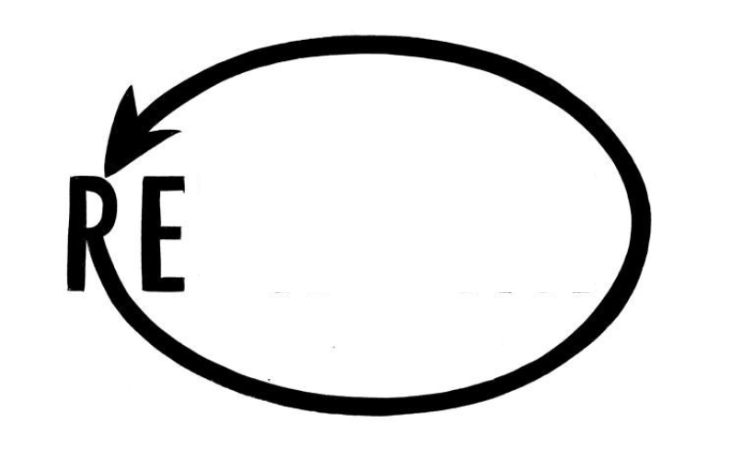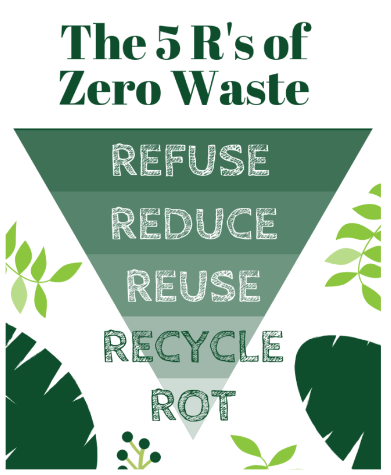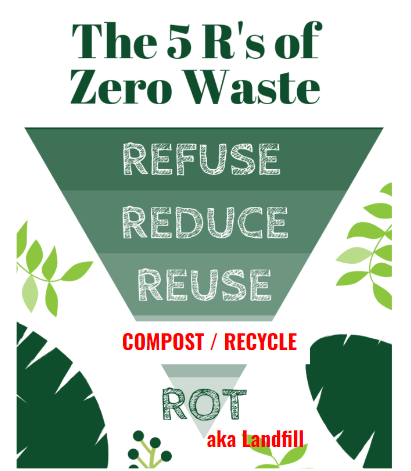This One Word is at the Top of the Pyramid when it comes to Sustainable Living

Can you fill in the blank?
In the 1970s, the jingle "Reduce, Reuse, Recycle" became popular. This was around the time that recycling was introduced in the U.S. as part of the "Resource Conservation and Recovery Act." In 1981, the first curbside recycling program was launched in Woodbury, NJ. The program only collected yard waste, metals, and paper. By 1988, there were 1,050 programs across the U.S., which grew to 5,202 by 1992. Today, there are more than 9,000 programs available in the United States (which still isn't nearly enough).
I'm not going to dive into the full history, but if you want to learn more, check out "History of Recycling" by Everyday Recycler.
Unfortunately, we only divert 32% of our waste to recycling facilities, according to the EPA. In total, we divert only 33.8% of our waste, which includes both composting and recycling. These are shockingly low numbers, and I know we CAN do better.
But it’s not just about recycling. As we know, reducing and reusing are even more important. You know what's even better?
REFUSE!

If you guessed correctly, give yourself a quick pat on the back.
Yes, the goal is to always REFUSE first, when possible.
Bea Johnson, author of Zero Waste Home, introduced the idea of a 5-tiered system in 2013. She offers ideas on how to minimize waste down to a single mason jar of garbage per year.
Here's the thing—I disagree with this chart. I’ve seen Bea Johnson speak, and I think she offers amazing ideas. But her audience is people who have the means to constantly refuse, reduce, refill, and go out of their way to create less waste. She even refills wine bottles for the love of Mother Earth—who has access to all of that?!
I’ve modified this chart to look more like this:

WHY? I want it to be more accessible to people.
In Bea’s graphic, "ROT" stands for compost. Composting is actually more important than recycling, but that’s not the point here. Instead, I put recycling and composting on the same level. Compost is just the recycling of organic materials. They should be treated equally in this context.
Then, I renamed "ROT" to represent the landfill. In Bea’s graphic, it implies that every item has a perfect place to go—that it has to check one of these boxes.
But that doesn’t work. We still have to account for the landfill. Why?
MOST ITEMS ARE MADE TO BE THROWN AWAY.
We currently live in a linear economy (as I mentioned earlier in this blog), which means items are destined for the landfill.
When we try to fit items into this perfect grid of Refuse, Reduce, Reuse, Recycle, we’re forcing things to go somewhere they don’t belong and contaminating our systems. Items that shouldn’t be placed in the recycling bin are ending up there. We’ve made people feel like they have to fit everything into one of these boxes.
But here’s a little secret…
It’s OK to throw things away if they can’t be reused or recycled properly.
We have to stop letting the guilt get to us when it comes to throwing things away. Our society wants us to throw things away.
Of course, you should always TRY first, but if you can’t, THAT’S OK.
It’s better to throw something away than to toss it into a bin for someone else to deal with. It’s better to throw it away than to contaminate our already very complex system.
I can’t stress this enough—it’s OK to throw things away and not fit them into a checkbox.
In our current system, the landfill still exists. When we acknowledge this, we can start working towards a system that works for everyone. When we acknowledge this, we can begin to understand the complexities of our recycling system and recycle right. When we acknowledge this, we can push for real system changes.
Until then… REFUSE and REDUCE as much as you can, and make sure you Recycle Right!